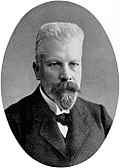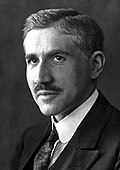Glycolysis
Glycolysis is a metabolic process in most organisms. It is the first stage in cellular respiration. It allows both aerobic and anaerobic respiration. Glycolysis releases only a small amount of energy. The word "glycolysis" comes from the Greek words γλυκύς (meaning "sweet") and λύσις (meaning "rupture").
Glycolysis is thought to be the archetype of a universal metabolic pathway. It occurs, with variations, in almost all organisms, both aerobic and anaerobic. The wide occurrence of glycolysis shows that it is one of the oldest known metabolic pathways.[1]
Glycolysis has ten intermediate compounds, catalysed by ten different enzymes. Only the broad outline is described here.
Process
Preparatory phase
The first half of glycolysis is the preparatory phase. It starts off by adding a phosphate group to glucose (Glucose 6-phosphate). Next, the Glucose 6-phosphate is converted into Fructose 6-phosphate. Another phosphate group is added turning it into fructose -1,6- biphosphate. The fructose -1,6-biphosphate is then split in two, one part turning into G3P (Glyceraldehyde-3-phosphate) and dihydroxyacetone phosphate. The dihydroxyacetone phosphate is converted into G3P, leaving us with the two G3P triose sugar molecules used in the Pay-off phase.
Pay-off phase
The second half of glycolysis is known as the 'pay-off phase', by the net gain of the energy-rich molecules ATP and NADH. Since glucose leads to two triose (G3P) sugars in the preparatory phase, each reaction in the pay-off phase occurs twice per glucose molecule. This yields 2 NADH molecules and 4 ATP molecules, leading to a net gain of 2 NADH molecules and 2 ATP molecules from the glycolytic pathway per glucose molecule.
Summary: 2ATP → 4ATP + 2(NADH + H+) + 2 pyruvate (net production of 2ATP)
Aerobic respiration
Cells performing aerobic respiration (respiration using oxygen) synthesize much more ATP, but not as part of glycolysis. These further reactions use the pyruvate from glycolysis.
Eukaryote aerobic respiration produces about 30 additional molecules of ATP for each glucose molecule. Glycolysis, through anaerobic respiration, is the main energy source in many cells.
Glycolysis Media
Yeast hexokinase B (PDB 1IG8)
Related pages
- Cellular respiration (overview)
- Link reaction
- Krebs cycle (Citric acid cycle)
- Electron transport chain (ETC)
References
- ↑ Romano A.H. & Conway T. 1996. Evolution of carbohydrate metabolic pathways. Res Microbiol. 147(6-7):448-55 PMID 9084754
Other websites
- The Glycolytic enzymes in Glycolysis Archived 2005-12-21 at the Wayback Machine
- Metabolism, Cellular Respiration and Photosynthesis - The Virtual Library of Biochemistry and Cell Biology Archived 2005-03-16 at the Wayback Machine
- Notes on glycolysis Archived 2008-06-11 at the Wayback Machine







